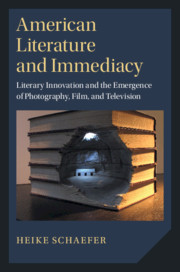 American Literature and Immediacy
American Literature and Immediacy from Part II - Literary Immediacy and the Cinema
Published online by Cambridge University Press: 19 December 2019
Stein used film as a model to explain the avant-garde poetics of her literary portraits to her perplexed readers. The chapter examines two early portraits, “Picasso” and “Orta,” in the context of chronophotography and early film. It also considers Stein’s theoretical reflections on her insistent style, particularly “Portraits and Repetition” and “How Writing Is Written.” Stein’s early portraits are in orientation temporal and performative (like film) rather than visual and static (like photography). They advance through sequences of similar, serially varied sentences that create the impression of an ongoing present. Stein’s cinematic form of serial variation locates meaning in the movement of its sentence permutations rather than in its mimetic capacities. Her serial sentences keep readers focused on the workings of language and the text’s temporal unfolding and thus manage to turn an awareness of representational processes into a tool to center our attention on the always elusive present moment. Stein’s use of self-reflexivity to create a sense of temporal and perceptual immediacy radicalizes the cinematic strategy of embedding immediacy effects in overtly self-referential texts.
To save this book to your Kindle, first ensure no-reply@cambridge.org is added to your Approved Personal Document E-mail List under your Personal Document Settings on the Manage Your Content and Devices page of your Amazon account. Then enter the ‘name’ part of your Kindle email address below. Find out more about saving to your Kindle.
Note you can select to save to either the @free.kindle.com or @kindle.com variations. ‘@free.kindle.com’ emails are free but can only be saved to your device when it is connected to wi-fi. ‘@kindle.com’ emails can be delivered even when you are not connected to wi-fi, but note that service fees apply.
Find out more about the Kindle Personal Document Service.
To save content items to your account, please confirm that you agree to abide by our usage policies. If this is the first time you use this feature, you will be asked to authorise Cambridge Core to connect with your account. Find out more about saving content to Dropbox.
To save content items to your account, please confirm that you agree to abide by our usage policies. If this is the first time you use this feature, you will be asked to authorise Cambridge Core to connect with your account. Find out more about saving content to Google Drive.